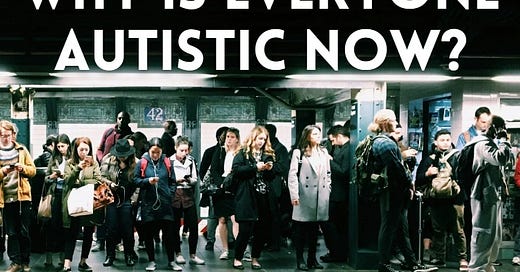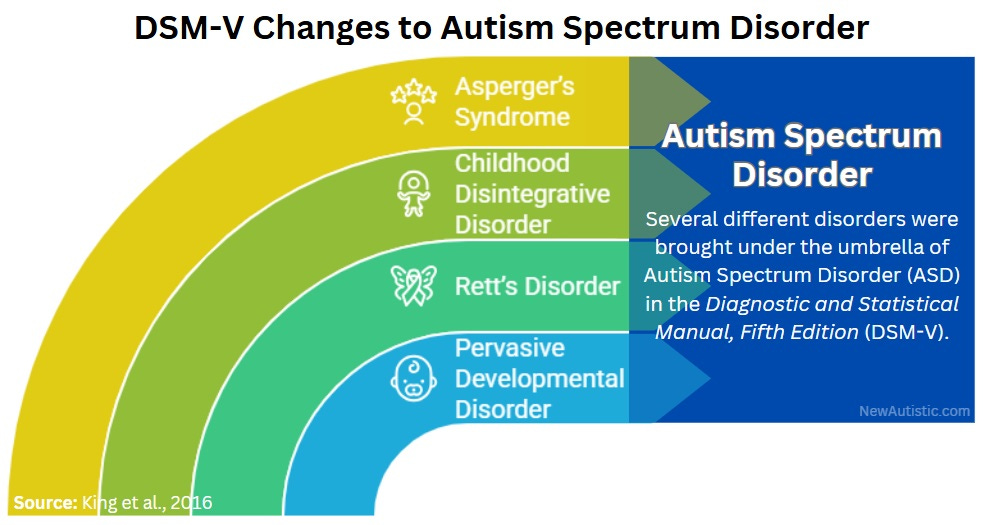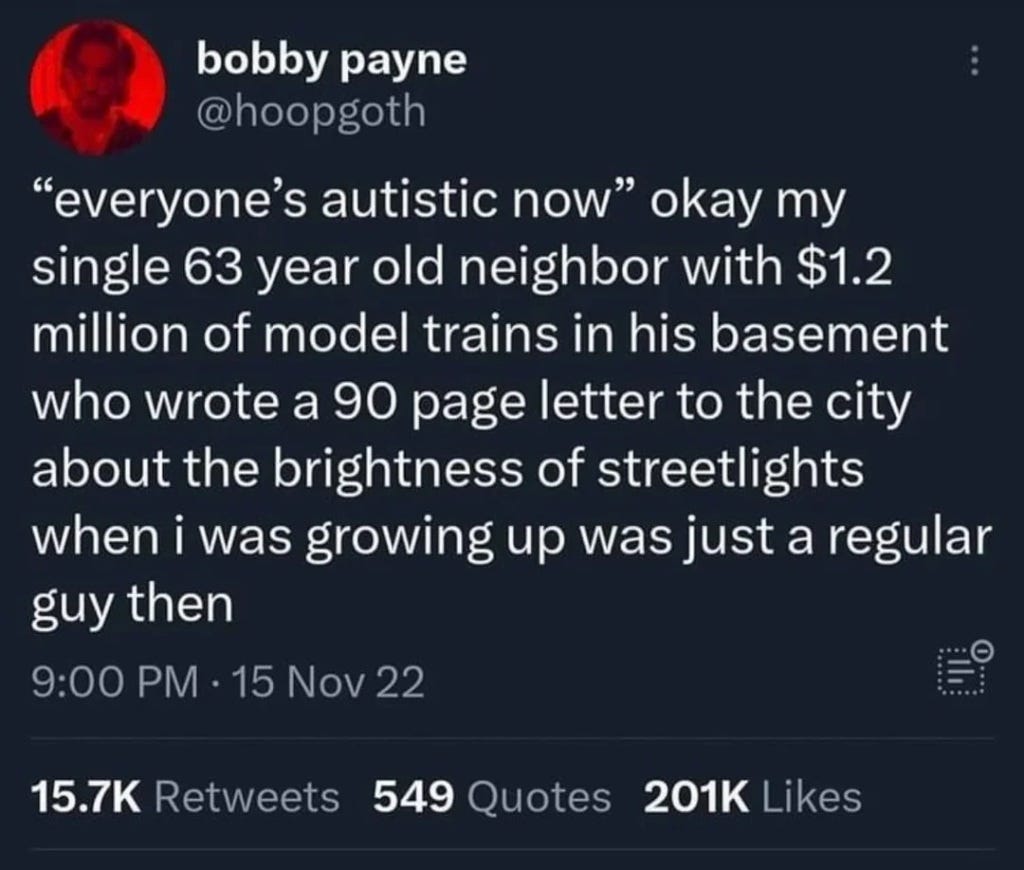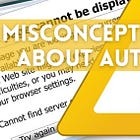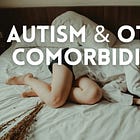Why is Everyone Autistic Now?
The Asperger’s to Autism Shift: How the 90s Framed Our Understanding
If you've lived anywhere else but under a rock for the past few decades, you'll have heard the apocryphal refrains that "rates of autism are skyrocketing" and "everyone's autistic now!" Obviously, there is a bit of hyperbolic liberty taken with these statements, but that hasn't stopped major news outlets, mainstream media, and people on social media from disseminating such information. What's the real deal? Is everyone autistic now? Are rates of autism actually skyrocketing?
I intend to examine these questions (and more that will be added to this page later) through a fact-seeking lens. Remember, however, that I am writing from the perspective of an autistic person, and if you've met one autistic person, you've met one autistic person. Other people, autistic or otherwise, may have differing opinions. (I should hope that they support their opinions with facts, like I do.)
Are Rates of Autism on the Rise?
The answer to this question seems to be both yes and no.
Yes
From a strictly statistical standpoint, yes, there are more people being diagnosed with autism today than there have been in the past. In the year 2000, about 1 in 150 children was diagnosed with autism according to the Centers for Disease Control and Prevention (CDC). That number jumped to 1 in 36 children in 2020, a four-fold increase. Understandably, a lot of people have been alarmed at this seemingly sudden and unforeseen increase in rates of autism.
Yes, But...
However, in order to understand this change (from 1 in 150 to 1 in 36) more clearly, the diagnostic criteria for autism must also be examined. If we've changed the way in which we diagnose autism, then it would make logical sense that numbers of diagnosed individuals might change.
The Diagnostic and Statistical Manual of Mental Disorders, Fifth Edition, commonly referred to as the DSM-V, was published in 2013 and revised in 2022. The DSM is "the taxonomic and diagnostic tool published by the American Psychiatric Association." Think of it as the Bible of American psychology and psychiatry. Other nations may use other criteria, so please note that I am speaking from a United States-based perspective.
In order to keep this easy to understand, I'm going to try to explain what happened with the diagnostic criteria for autism in laymen's terms. (If you want a more in-depth explanation and analysis, I recommend reading the book Neurotribes by Steve Silberman.) In 2013, the DSM-V overhauled autistic disorder to Autism Spectrum Disorder (ASD), bringing in similar disorders like the now-discarded Asperger's Syndrome, Pervasive Developmental Disorder (PDD-NOS), Rett's Disorder, and childhood disintegrative disorder under the umbrella of the new ASD.
Putting multiple other disorders like Asperger's and PDD under the umbrella of ASD is quite obviously going to cause rates of ASD to go up. What might've in the past been diagnosed as one of these other disorders now falls under the ASD diagnostic criteria. Therefore, it makes perfect sense that rates of ASD would go up from that alone.
Furthermore, autism was once thought only to affect boys, or at least was thought to be much more prevalent in males than females. While it's true that boys (and affluent white boys especially) are far more likely to be diagnosed — because that was the group most heavily studied — we now know that autism often presents differently in males and females and there could be just as many female autistics as there are males. (At the very least, the numbers are not so disparate as they were once believed to be.)
If we previously excluded roughly 50 percent of the population on the basis of their sex, it makes perfect sense that rates of autism would seem to be on the rise once we start more seriously evaluating the other sex for ASD. In simpler terms, more women are getting evaluated and diagnosed.
Similarly, we see the same effect in people of color. In the past, most people diagnosed with autism were white and upper-middle class. Now that other races and ethnicities are being studied more extensively in terms of ASD, more people of color are being diagnosed, and that also increases the total number of ASD diagnoses.
No
There's also an argument to be made that rates of autism aren't actually increasing; only the rates of autism diagnosis are increasing. What do I mean by this?
Let's look at Mt. Everest. It was ostensibly discovered in 1852 by surveyors working for the British government. But that doesn't really make sense because, obviously, Mt. Everest was there in 1851, and in 1850, and in 1849, and so on and so forth. Earth's tallest peak didn't suddenly poof into existence just because some British surveyors went poking around Nepal in 1852, right? Mt. Everest existed long before then -- we just didn't know where to look.
And many argue that it's the same with autism: autism has always been here; we just didn't know where to look. As Temple Grandin (a famous autistic author, speaker, and professor) has posited:
"Who do you think made the first stone spear? That wasn't the yakkity yaks sitting around the campfire. It was some Asperger sitting in the back of a cave figuring out how to chip rocks into spearheads."
The Real Answer
Whether rates of autism itself are going up is another debate entirely, but it's clear from the evidence that rates of ASD diagnosis are indeed on the rise, and will likely continue to rise for the foreseeable future.
Is Everyone Autistic Now?
Another question I see commonly floated on social media is, "Why is everyone autistic now?" I would attribute hyperbole to some of these commenters, but I also agree that they do have a point: far more people are being diagnosed with autism/ASD than ever before. We see it in media (books, movies, and television). We see it in online spaces. We see it in schools and workplaces. So, what's going on?
Some Famous People with Autism
Many big-name celebrities, artists, actors, and businessmen have revealed their diagnoses over recent years, including Anthony Hopkins, Eminem, Elon Musk, Satoshi Tajiri (the creator of the Pokémon franchise), and Courtney Love — just to name a few. Many, many more are suspected of being on the autism spectrum.
Furthermore, many people speculate that a ton of prominent people throughout history would meet the criteria for an ASD diagnosis today, including Charles Darwin, Albert Einstein, Carl Jung, Emily Dickinson, George Orwell, Andy Warhol, Nikola Tesla, and Vincent van Gogh — again, just to name a few. In Silberman's Neurotribes, he expands on several prominent scientists who almost certainly would've been considered autistic today.
But Why is Everyone Autistic?
To be clear (and although this should go without saying, I'll say it): not everyone is autistic now. There may be more representation of autistic people in media, and certainly more people are getting diagnosed, but that is a far cry from "everyone" being autistic.
ASD is still a relatively rare disorder that is currently diagnosed in about 2.8 to 4.5 percent of the population (as of 2023 statistics). Those rates are similar, though slightly lower, to rates of people who are blind or have a vision disability (4.8 percent) or people who are deaf or have serious difficulty hearing (6.1 percent).
The Frequency Illusion
In truth, most people probably are noticing autism more (and therefore thinking it's far more prevalent than it is) due to the Baader-Meinhof phenomenon, also known as the frequency illusion. This cognitive bias occurs when you notice a specific word, thing, person, product, etc. more frequently after being made aware of it.
For example, say I tell you that there are a lot more crows this year than in previous years, and you might mention that you hadn't noticed that. However, now that the idea is in your head, you go out to the grocery store and see (what you think are) more crows. At the park, you see more crows. On a walk, you see more crows. You come back to me a week later and agree, "Yeah, there definitely are more crows around!"
In actuality, there aren't any more crows than there were before; you're only noticing the crows because I pointed their supposed increasing numbers out to you. The crows were always there hanging out in the grocery store parking lot, or chilling near the local park, or up in the trees on your nature walks. You just weren't looking for them before, and now that you are, you notice them.
Remember the whole Mt. Everest comparison I mentioned in the previous section? It's the same thing: the crows were always there; you just weren't looking for them before. Thanks to the frequency illusion, you're noticing them now. (And try not to be on the lookout for more crows after reading this.)
No, Not Everyone is Autistic, But...
Not everyone is autistic, but (there's always a but, huh?) it's true that far more people are being diagnosed with autism than ever before. I think a huge part of the problem is that the overhaul of ASD, along with the inclusion of other, now-eliminated diagnoses, has really muddied the waters when it comes to the public perception of what autism is or isn't (and to learn more about misconceptions about autism, check out my article Misconceptions About Autism).
I want to dive into this more because I think it's really important to understand the nuance of the situation. In doing so, I may use some language or descriptors that some may find offensive, and I apologize in advance. Please understand that it is not meant with the intention of harm or offense but rather elucidation.
Autism & Asperger's: A 90s Tale
I grew up in the 90s and early 2000s, and during that time, there were two distinct categories: autism and Asperger's Syndrome. Kids who were autistic couldn't do much for themselves. Perhaps they were nonverbal, or constantly threw what their caretakers referred to as "tantrums," or they only ate one food item (often something like fries or chicken nuggets). They didn't attend normal school. They were often referred to as "retarded" in both the literal and pejorative sense.
On the other hand, kids with Asperger's Syndrome were intelligent, sometimes much more so than their peers, had extensive vocabularies (hyperlexia), and had special abilities when it came to math, science, writing, or art. Often, they were referred to as "gifted children." Despite their vast cognitive abilities, they typically had limited social and emotional intelligence and had trouble getting along with other children their own age.
Given this, imagine the shock and horror when, with the release of the DSM-V in 2013, the "gifted children" and the "retards" were suddenly put under the same umbrella: Autism Spectrum Disorder (ASD). The new ASD, its levels, and its changes weren't explained well — if at all — to the American public. (To learn more about the new levels of ASD and what they mean, read my article The Three Levels of Autism next.)
An Example: Steven and Lyle
Most people, understandably, don't know about the overarching changes to autism and ASD. All they see is that Steven, a gifted child who graduated high school at 16 and went on to get a law degree from Harvard, suddenly has the same diagnosis as Lyle, a nonverbal invalid who can't even feed, clothe, or bathe himself. (Note that I just made these examples up and they do not refer to any specific person or persons.) How could these two completely opposite people possibly have the same disorder?
Furthermore, those parents of children with what is now often referred to as "profound autism" (individuals with ASD with an IQ less than 50 and require 24-hour supervision) are looking at Steven and his accomplishments and (perhaps rightfully) demanding to know why the extremely limited resources out there for ASD are going to Steven.
"Steven went to Harvard! My son, Lyle, can't even tie his shoe! Why does Steven need support?!" is a common and expected refrain that we might hear from loved ones of those with profound autism. "Steven's not actually autistic! He can clearly take care of himself and that's not what autism is!" Perhaps you think they're right.
But the truth is that even though Steven is able to function at a higher level intellectually and socially than Lyle, that doesn't mean he isn't in need of support himself. What Lyle's parents don't know is that Steven is hanging on by a thread, addicted to alcohol to the point of developing jaundice just to survive the rigors of being a high-powered attorney. That's not to say that he needs as much support as Lyle does, as he certainly doesn't, but he needs at least some support to survive.
The Real Problem
The biggest problem, aside from a lack of education on what ASD actually means now, is the lack of support in general for autistic people. Let's take a look at some troubling, not-so-convenient data points.
Shorter Life Expectancy
A person with autism only has a life expectancy of 39-54 years, compared to the average person's 77.5-year life expectancy in the US.
Chronic Unemployment
Depending on the study, approximately 38.5 percent to 85 percent of autistic people are unemployed, even those with college or post-graduate degrees.
Serious Comorbidities
Autism comes with a ton of potential comorbidities (conditions that are often found together), including attention deficit hyperactivity disorder (ADHD), gastrointestinal issues, chronic inflammatory illnesses, epilepsy, cerebral palsy, migraines, headaches, and congenital abnormalities, just to name a few. (Hint: It's not just the autism that we struggle with.)
Higher Substance Abuse Rates
50 percent of autistic people have substance use disorder. Autistic people are also more likely to use recreational drugs to self-medicate.
More Prone to Being Abused
Autistic adults experience higher rates of abuse (sexual, emotional, verbal, physical) than non-autistic adults. Autistic youths are 3-4 times more likely to experience sexual victimization.
Higher Rates of Mental Health Issues
Autistic people are more likely to experience mental health issues relating to anxiety, depression, and post-traumatic stress disorder (PTSD) compared to non-autistic people.
And Many, Many More Issues
If you want a glimpse into more potential comorbidities related to autism, check out my article Autism & Other Comorbidities.
Examining Steven and Lyle again, can we really say that Steven isn't deserving of any support at all, considering all of the potential issues that come with being autistic? Or is it more fair to say that there clearly aren't enough resources to support autistic people and their families as things are now and we need more resources going forward?
Profound Change is Needed
If we want to make life better for autistic individuals, we as a society are going to need to step up. We need organizations that don't just dabble into seeking a "cure" for autism but rather those that support the autistic people that are here now, who are just trying to survive, who are struggling, and who are unfortunately dying far earlier than they should be, either by suicide or other comorbid illnesses.
It's not about who doesn't "look autistic" or who isn't "disabled enough." It's about what tangible resources and support we can provide to autistic people at any level. Some people with profound autism might need more support than others, and that's totally fine. But let's not forget the Stevens of the world and everyone else in-between: we are people who are also struggling and we need support as well.
Thanks for Reading!
Thanks for taking time out of your busy day to spend some time with me! I encourage all of my readers to RISE (Reflect, Improve, Strengthen, & Evolve) with me because healing is a lifelong journey — it’s not always easy, but it’s always worth it. You are loved, cherished, and valued. Don’t ever let anyone ever convince you otherwise.
My commitment to bringing you FREE, well-researched, and comprehensive content means I spend considerable time and effort writing each article or post without compensation.
Want to Support Me?
The simplest FREE way you can support me is by subscribing, sharing, or leaving a comment:
I believe in keeping my content accessible to everyone, without paywalls, because I know the work I do matters. For that reason, I’m beyond grateful for any financial support! If you'd like to support me and my work, check out my art website at AriesArtwork.com to bring home something unique or find a gift for that special someone in your life:
I’ll see you again when I’ve got a new info-dump for you, my Newtistics Crew!
—Skylar Aries


